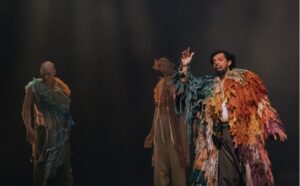
At the start of October, the show “O Grão da Voz” (The Grain of the Voice) with the acclaimed Brazilian male soprano Bruno de Sá was presented at Theatro São Pedro, in São Paulo. Bruno and Ligiana Costa, the show’s stage director, gave an interview to João Marcos Copertino on OperaWire. The concert is available on YouTube .
The Grain is the Body “The ‘grain’ is the body in the voice as it sings, the hand as it writes, the limb as it performs,” writes Ronald Barthes in his essay “Le Grain de la Voix,” published in 1972 at the magazine “Musique en Jeu.” In the introduction of the text, Barthes points out to the fact that many music critics use an excess of adjectives that are mostly empty of real meaning. It also takes us back to the essence of the voice, its physical and corporeal attributes.
The concept sounds fascinating, but for me there is something in the essay that makes it a hard pill to swallow: Barthes elected Dietrich Fischer-Dieskau as an example of a grain-less singer, placing Charles Panzéra as the grain-full vocalist. To Barthes defense, Panzéra was a master of French song in the inter-war period and also his own singing teacher, for whom he felt deep admiration, borderline obsession. Ligiana Costa first heard Bruno when he was still a student.
When she heard his voice, she immediately linked the sound to the Barthesian concept. That is how, when directing a show with him as the headliner star, she could not choose a different title, “The Grain of the Voice,” nor a different subject, his voice. Bruno de Sá stepped onto the stage singing the aria that in the voice of the great diva Maria Callas became an emblem of vocal arts: “Casta Diva,” from Vincenzo Bellini’s opera “Norma.
” From the pit, conducted by the excellent André dos Santos elicited from Theatro São Pedro’s Orchestra a delicate, homogeneous sound that allowed Bruno’s voice to float beautifully. Indeed, throughout the concert, the quality of the orchestra was remarkable – precision, cohesion and dynamics – despite, at least at the premiere, it sometimes sounded a little bit too loud, sometimes sweeping Bruno’s voice away. Bruno has a brilliant and pure instrument.
Although it projects well, his voice is delicate. That’s why – and not because of gender – his voice works so well in baroque and classical repertoires and with period instruments. The romantic orchestra, which is denser and designed for larger concert halls, tends to obscure the details of the soprano’s subtle way of singing.
Production Details During the first aria, in front of the singer there was a screen on which Vic von Poser made beautiful, dynamic projections that looked like sprouting branches. This start was the most exciting and magical moment of the show: it was Bruno’s voice, the voice that Brazil is so proud of, blossoming from the “grain.” “Casta Diva” isn’t about the voice, the voice isn’t part of Norma’s theme.
However, in this aria it’s the voice that matters, it’s the breathing, it’s the support, it’s the legato that Bruno handled so well. It’s not theory, but the practice of singing. So, it was a pity that, as a good musicologist, Costa’s academic side won out during the preparation of the show and the quotes and theories about the voice and singing soon prevailed.
The use of digitized sounds on the one hand has brought content to the show, but on the other, it interfered in the physical, intimate contact with the unamplified voice that springs from the singers’ bodies. In other words: the empirical discovery of the “grain of the voice.” Even though the singers and orchestra weren’t amplified, the recordings that alternated with the musical numbers broke the atmosphere – especially the recording of “Pronta pra cantar,” by Caetano Veloso, in the voices of Nina Simone and Maria Bethânia, no matter how much grain Simone’s and Bethânia’s voices have.
At the end, after Bruno sang Alben Berg’s “Die Nachtigall,” the show closed with a recording of Benjamin Clementine’s song “At Least for Now,” a voice whose body was not present on stage that gave the final word. In a battle between academic words and vocal soulful sound, I certainly side by the latter. In a moment of the show, we could hear a recoded interview of Francisco Campos Neto, Bruno’s voice teacher and São Paulo’s legend.
But much more interesting was to see Campos Neto himself surveilling and teaching Bruno on stage — with his eyes —while the soprano sang Mozart’s “Solfeggio (K 393),” arranged by Juliana Ripke . Mozart’s melody has words, the voice wins. More Singing Highlights It was a great idea to bring Campos Neto to the stage in a show focusing on the voice — especially that of Bruno de Sá.
He symbolizes the singing teacher’s successful work. As well as Bruno’s, Campos Neto was also the teacher of another Brazilian singer who is making great progress in her international career: mezzo-soprano Marcela Rahal , who won the “Tenor Viñas” competition held in January; and this year alone, Rahal is already taking part in her second production at the Teatro alla Scala. In this sense, Campos Neto represented the value and importance of the work done off stage: not only the study that precedes a successful career, but also that which sustains it, and which should support the artist throughout their journey.
The only thing I kept wondering was: instead of recording, couldn’t Campos Neto speak live, as he does in the classroom? And speaking of the education of singers, this was the second concert that Bruno presented with singers from Theatro São Pedro Academy, ending a period of collaboration between the renowned singer and the theater. Not so long ago, Bruno was part of the same academy, which makes this collaboration even more significant. The cast included Débora Neves (soprano), Laleska Terzetti (mezzo-soprano), Ariel Bernardi (female baritone) and Wilian Manoel (tenor).
We should not forget that the academy of an opera house is the intermediate step between student life and a professional career. Although the results of the ensemble numbers were very good – especially the beautiful “Abendesegen,” from Humperdinck’s “Hänsel und Gretel,” very well sung by Débora Neves and Laleska Terzetti – the individual numbers revealed that there is a singer who still needs to study a lot before she can think about performing professionally. I wonder: does joining an opera academy really help singers with serious vocal technique problems, or does it just deceive and hinder them? Strictly from the point of view of the concert, however, if it is the voice that is in focus, this mixture of voices at different levels of study and maturity is interesting.
On the same stage were the most important Brazilian operatic voices today and students at different levels, some close to professional life, others far away. This gave the show its grain. Illuminating Bruno de Sá Let’s talk about Bruno.
In addition to the works already mentioned, he performed two baroque arias – “Aux langueurs d’Apollon” from Rameau’s opera “Platée,” and “Siam navi all’onde algenti” from Vivaldi’s “L’Olimpiade” – and the Martelo from Heitor Villa-Lobos’ “Bachianas No. 5.” Especially in the aria di paragone “Siam navi all’onde algenti” – in which Aminta compares us to ships on silver waves, left to their own fate, where our affections are impetuous winds – Juliana Ripke’s interesting and contemporary arrangement distorted the accompaniment in the last repetitions, introduced dissonances, rhythms, promoting a dialog between the Baroque and the contemporary.
“All life is a sea,” sings Aminta in the aria, and the sea was given an efficient stage representation. Bruno was able to demonstrate the agility of his singing and the brilliance of his high notes. Visually Stunning Moments The show had a beautiful visual finish.
This is largely due to the care and dedication of Ligiana Costa, who seems to have given herself wholeheartedly to this show, and also to the great team that surrounded her. In addition to those already mentioned, Renato Bolelli Rebouças (art direction and set design), Alma Negrot (costumes), Aline Santini (lighting) and Roberto Alencar (choreography). It’s also worth noting that both the scenery and the costumes were made from the archives of the city’s two theaters: Theatro São Pedro itself and Theatro Municipal de São Paulo.
In addition to the good reuse of items, this is a sign of the healthy cooperation between the theaters. After the show, I asked Bruno what the announcement that this third concert would close a cycle with the São Pedro Theater meant. The answer was exactly what I had feared: his contract with the São Pedro had ended and, so far, no other theater had contacted him.
This information is confirmed in the interview Bruno and Costa gave to Opera Wire. Next year, it seems, we won’t see this national pride, the international star, in Brazil. Meanwhile, on October 25th, Erato (Warner), one of the most important labels on the market, will release Bruno’s second solo album: “Mille Affetti,” dedicated to the Classical era.
I am not surprised, I knew it from the first time I heard Bruno, in 2016, when he won the Maria Callas Brazilian Singing Competition: Bruno belongs to the world, not to Brazil. Categories.














